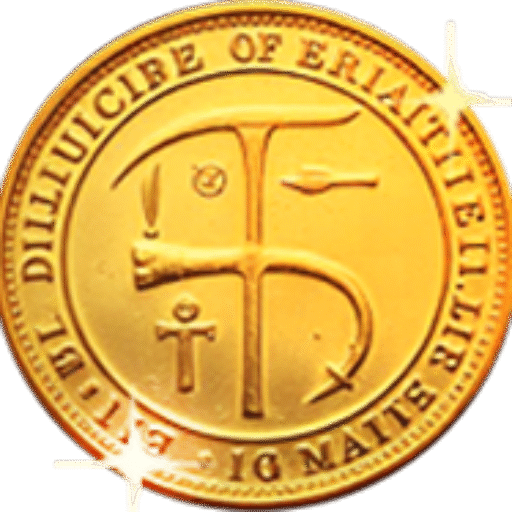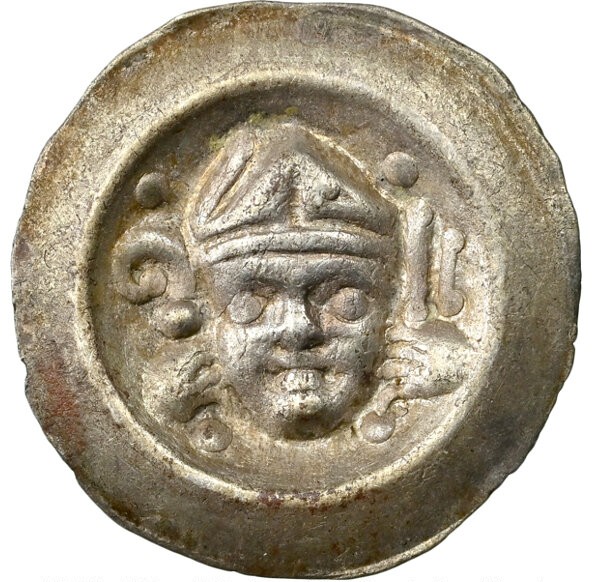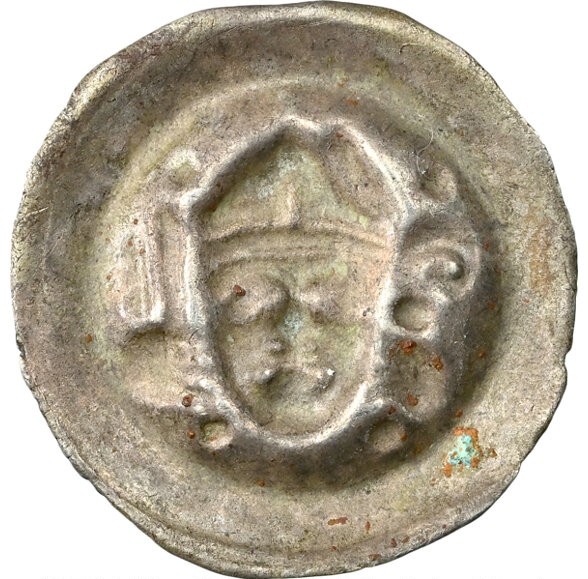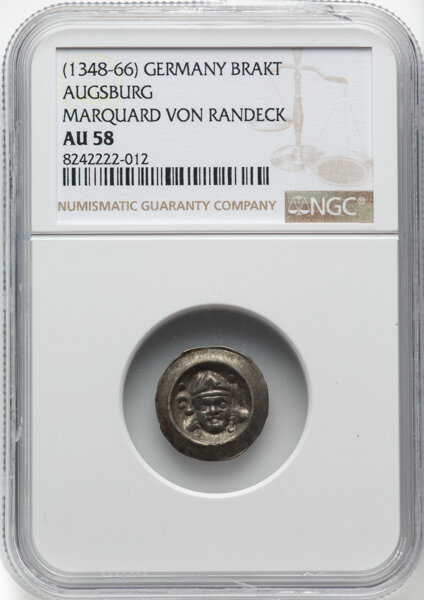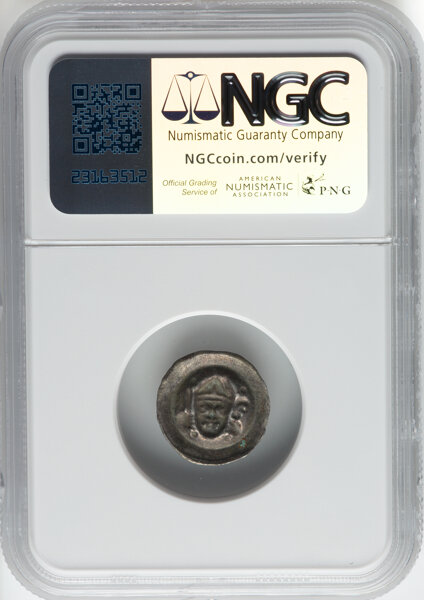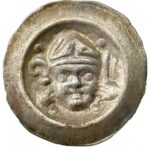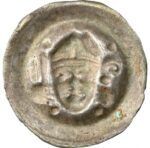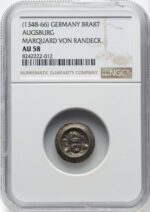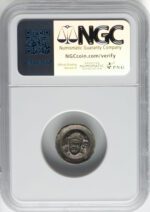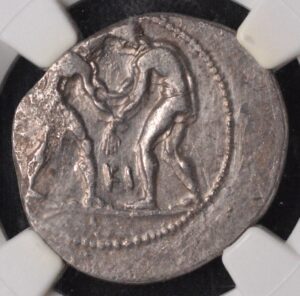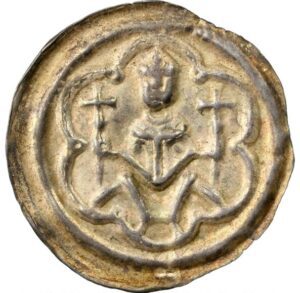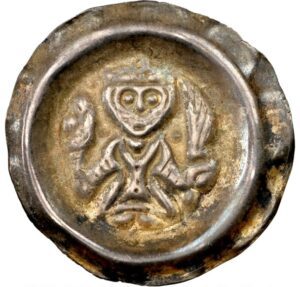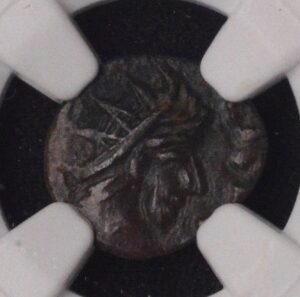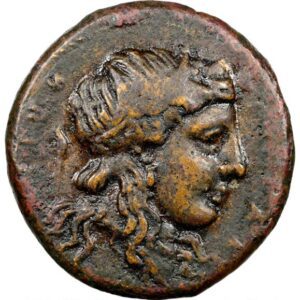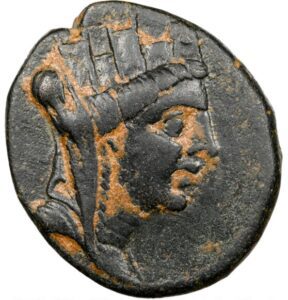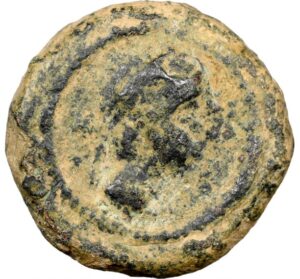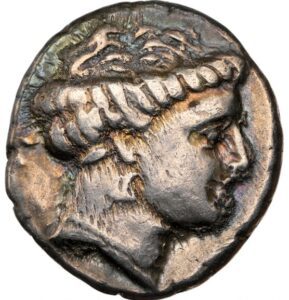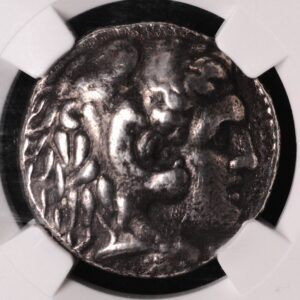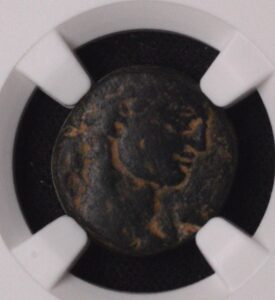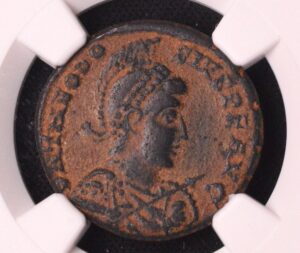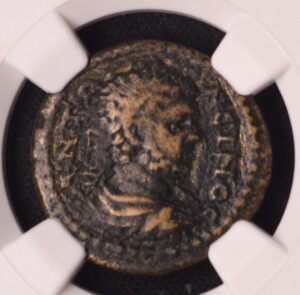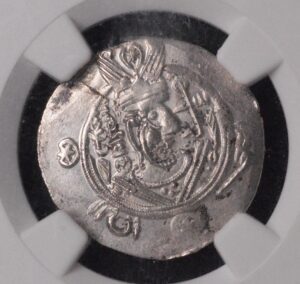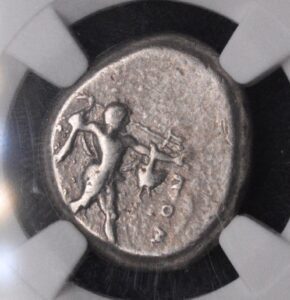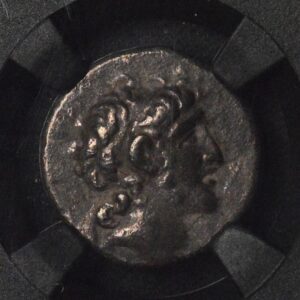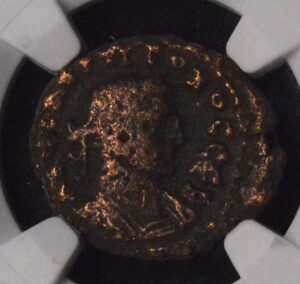Description
The bracteate of Marquard von Randeck, issued during his tenure as Prince-Bishop of Augsburg (1348–1366), is a silver medieval coin representative of late Gothic ecclesiastical minting in southern Germany. These thin, single-sided bracteates were struck in Augsburg under episcopal authority and served both as currency and symbolic seals of the bishop’s temporal power. The issue marks a transitional phase in German bracteate art, reflecting both religious iconography and the refined craftsmanship of the mid-14th century.
This small silver coin, typically weighing around 0.4 to 0.5 grams and measuring 18–19 mm in diameter, features a bust of Bishop Marquard von Randeck facing forward, holding a crozier (pastoral staff) in one hand and a book of scriptures in the other—symbols of episcopal authority and learning. The edges are encircled by a beaded or dotted border, characteristic of Augsburg mint output in this era. The reverse of the coin is concave, as is typical for all bracteates, formed by a single strike into a prepared silver sheet.
Marquard von Randeck was a figure of considerable historical importance beyond numismatics. Serving as both a prince-bishop and later Patriarch of Aquileia, he played a prominent role in imperial politics as a chancellor to Emperor Charles IV. His coinage thus represents not only ecclesiastical significance but also the intersection of imperial and religious authority during the height of the Holy Roman Empire’s influence.
An NGC AU58 example would signify an exceptionally well-preserved specimen of this fragile coin type, retaining near-complete portrait relief, crisp internal details, and minimal flan cracking. These pieces are difficult to find in such condition because bracteates, being wafer-thin, were highly susceptible to bending or breaking even under moderate circulation.
In sum, the Augsburg Marquard von Randeck bracteate (1348–1366) encapsulates late medieval ecclesiastical minting artistry. It stands as both a historical and artistic testament to a bishopric that wielded immense power in the Holy Roman Empire’s southern territories, making this coin a prime example of Gothic religious coin engraving at its finest.
The bracteate of Marquard von Randeck, issued during his tenure as Prince-Bishop of Augsburg (1348–1366), is a silver medieval coin representative of late Gothic ecclesiastical minting in southern Germany. These thin, single-sided bracteates were struck in Augsburg under episcopal authority and served both as currency and symbolic seals of the bishop’s temporal power. The issue marks a transitional phase in German bracteate art, reflecting both religious iconography and the refined craftsmanship of the mid-14th century.
This small silver coin, typically weighing around 0.4 to 0.5 grams and measuring 18–19 mm in diameter, features a bust of Bishop Marquard von Randeck facing forward, holding a crozier (pastoral staff) in one hand and a book of scriptures in the other—symbols of episcopal authority and learning. The edges are encircled by a beaded or dotted border, characteristic of Augsburg mint output in this era. The reverse of the coin is concave, as is typical for all bracteates, formed by a single strike into a prepared silver sheet.
Marquard von Randeck was a figure of considerable historical importance beyond numismatics. Serving as both a prince-bishop and later Patriarch of Aquileia, he played a prominent role in imperial politics as a chancellor to Emperor Charles IV. His coinage thus represents not only ecclesiastical significance but also the intersection of imperial and religious authority during the height of the Holy Roman Empire’s influence.
An NGC AU58 example would signify an exceptionally well-preserved specimen of this fragile coin type, retaining near-complete portrait relief, crisp internal details, and minimal flan cracking. These pieces are difficult to find in such condition because bracteates, being wafer-thin, were highly susceptible to bending or breaking even under moderate circulation.
In sum, the Augsburg Marquard von Randeck bracteate (1348–1366) encapsulates late medieval ecclesiastical minting artistry. It stands as both a historical and artistic testament to a bishopric that wielded immense power in the Holy Roman Empire’s southern territories, making this coin a prime example of Gothic religious coin engraving at its finest.
The bracteate of Marquard von Randeck, issued during his tenure as Prince-Bishop of Augsburg (1348–1366), is a silver medieval coin representative of late Gothic ecclesiastical minting in southern Germany. These thin, single-sided bracteates were struck in Augsburg under episcopal authority and served both as currency and symbolic seals of the bishop’s temporal power. The issue marks a transitional phase in German bracteate art, reflecting both religious iconography and the refined craftsmanship of the mid-14th century.
This small silver coin, typically weighing around 0.4 to 0.5 grams and measuring 18–19 mm in diameter, features a bust of Bishop Marquard von Randeck facing forward, holding a crozier (pastoral staff) in one hand and a book of scriptures in the other—symbols of episcopal authority and learning. The edges are encircled by a beaded or dotted border, characteristic of Augsburg mint output in this era. The reverse of the coin is concave, as is typical for all bracteates, formed by a single strike into a prepared silver sheet.
Marquard von Randeck was a figure of considerable historical importance beyond numismatics. Serving as both a prince-bishop and later Patriarch of Aquileia, he played a prominent role in imperial politics as a chancellor to Emperor Charles IV. His coinage thus represents not only ecclesiastical significance but also the intersection of imperial and religious authority during the height of the Holy Roman Empire’s influence.
An NGC AU58 example would signify an exceptionally well-preserved specimen of this fragile coin type, retaining near-complete portrait relief, crisp internal details, and minimal flan cracking. These pieces are difficult to find in such condition because bracteates, being wafer-thin, were highly susceptible to bending or breaking even under moderate circulation.
In sum, the Augsburg Marquard von Randeck bracteate (1348–1366) encapsulates late medieval ecclesiastical minting artistry. It stands as both a historical and artistic testament to a bishopric that wielded immense power in the Holy Roman Empire’s southern territories, making this coin a prime example of Gothic religious coin engraving at its finest.
CUSTOMER FEEDBACK








Related Products & Newly Released!
-
$400.00




SHIPPING POLICY
Your order is shipped from the United States with USPS tracking within one business day.
14 Day Return Policy
You can return your item back within
14 days of the purchase

Secure payments
Your payments are 100% secure and are processed through Square or PayPal on a protected security network.
SHIPPING POLICY
FREE International and Domestic (United States) shipping. Your order is shipped with USPS tracking 24 hours after you order.
14 Day Return Policy
You can return your item back within
14 days of the purchase

Secure payments
Your payments are 100% secure and are processed through Square or PayPal on a protected security network.
RESOURCES
support
Get Fresh Articles!
Sign up now to receive our articles for the latest insights and promotions!
RESOURCES
support
Get Fresh Articles!
Signup our newsletter to get update insight or promotions.

